It’s Never Opposite Day With Framber Valdez on the Mound
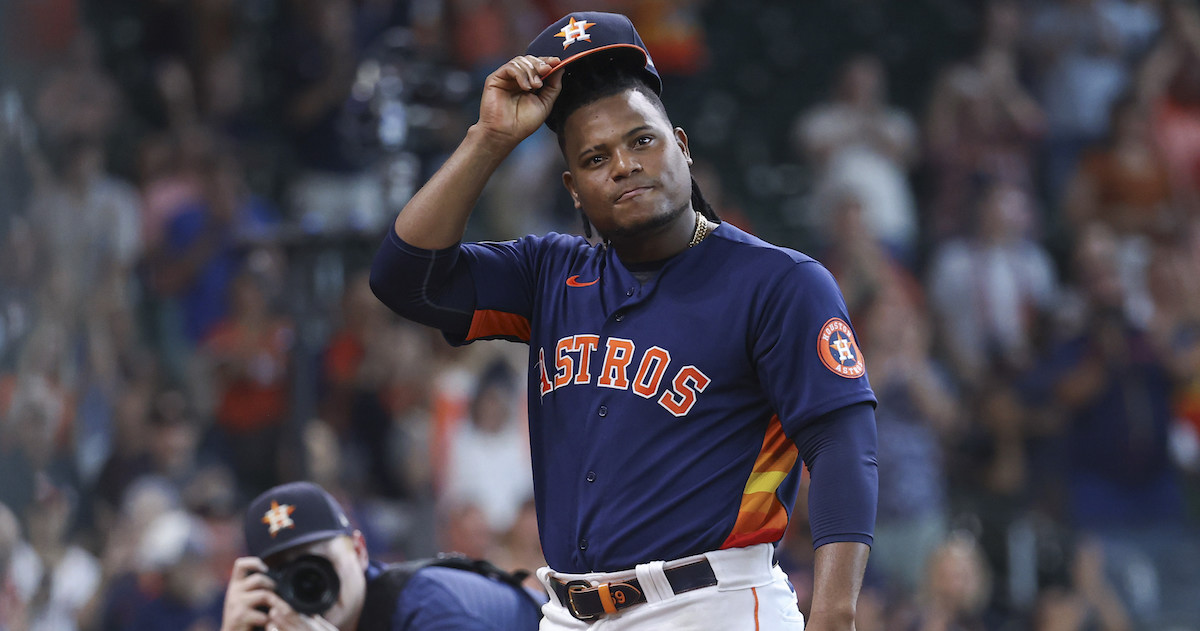
This is Leo’s first piece as a FanGraphs contributor. Leo is a Philadelphia sports fan, but he lives in Toronto, meaning he is subjected to the agony of watching Joe Carter’s 1993 World Series-winning walk-off home run replayed on a loop every single time he attends a Phillies game. Nevertheless, his love of the game has persevered. He has written for sites across the web, including Baseball Prospectus, Inside the Phillies, PitcherList, and The Good Phight. He is also a comedy writer and occasionally tries his hand at mixing baseball and humor. Sometimes it goes well; sometimes his work is called “bad satire” and “a waste of time.”
Stop me if you’ve heard this one before, but Framber Valdez is having a historic season.
Earlier this year, Justin Choi wrote about Valdez and his historic groundball-to-fly ball ratio through the first six weeks of the season. Valdez has always been good at inducing groundballs and limiting fly balls, but his 10.00 GB/FB ratio over his first seven starts was on another level.
Unsurprisingly, Valdez himself was on another level, too. Through May 18, he posted a 2.93 ERA and 3.33 FIP in 40 innings pitched. His journey from middle-relief prospect to top-of-the-rotation starter was complete. Groundballs were always his super power, and fly balls had long been his kryptonite, so it made perfect sense he was thriving after increasing his GB/FB ratio. Since mid-May, however, his GB/FB ratio has slowly been coming back to Earth. It now sits at 4.20, which is still excellent to be sure, but not exactly sky-scraping. Yet Valdez is still having a historic season – just in a different way.
On Sunday afternoon, the Houston Astros left-hander made his 25th consecutive quality start, setting a new major league record. Sure, quality starts aren’t the strongest metric for evaluating starting pitchers, but that’s beside the point here. You don’t make 25 straight quality starts (and counting) if you aren’t a good pitcher. Indeed, Valdez has been fantastic this season. He made his first All-Star team, set a big league record, and blossomed into one of the very best pitchers in the American League.
Yet it’s no longer simply because of his elite groundball-to-fly ball ratio. He still leads the league in that metric, but since mid-May, his GB/FB ratio has been noticeably lower than his career average. He is allowing fewer balls on the ground and more balls in the air, but he has found a way to prevent those balls in the air from hurting him. What’s his secret?
He’s protecting the opposite field. Over his past 12 starts, Valdez has been allowing significantly less opposite field contact, especially on balls hit in the air. So far, this plan of action has yielded tremendous results:
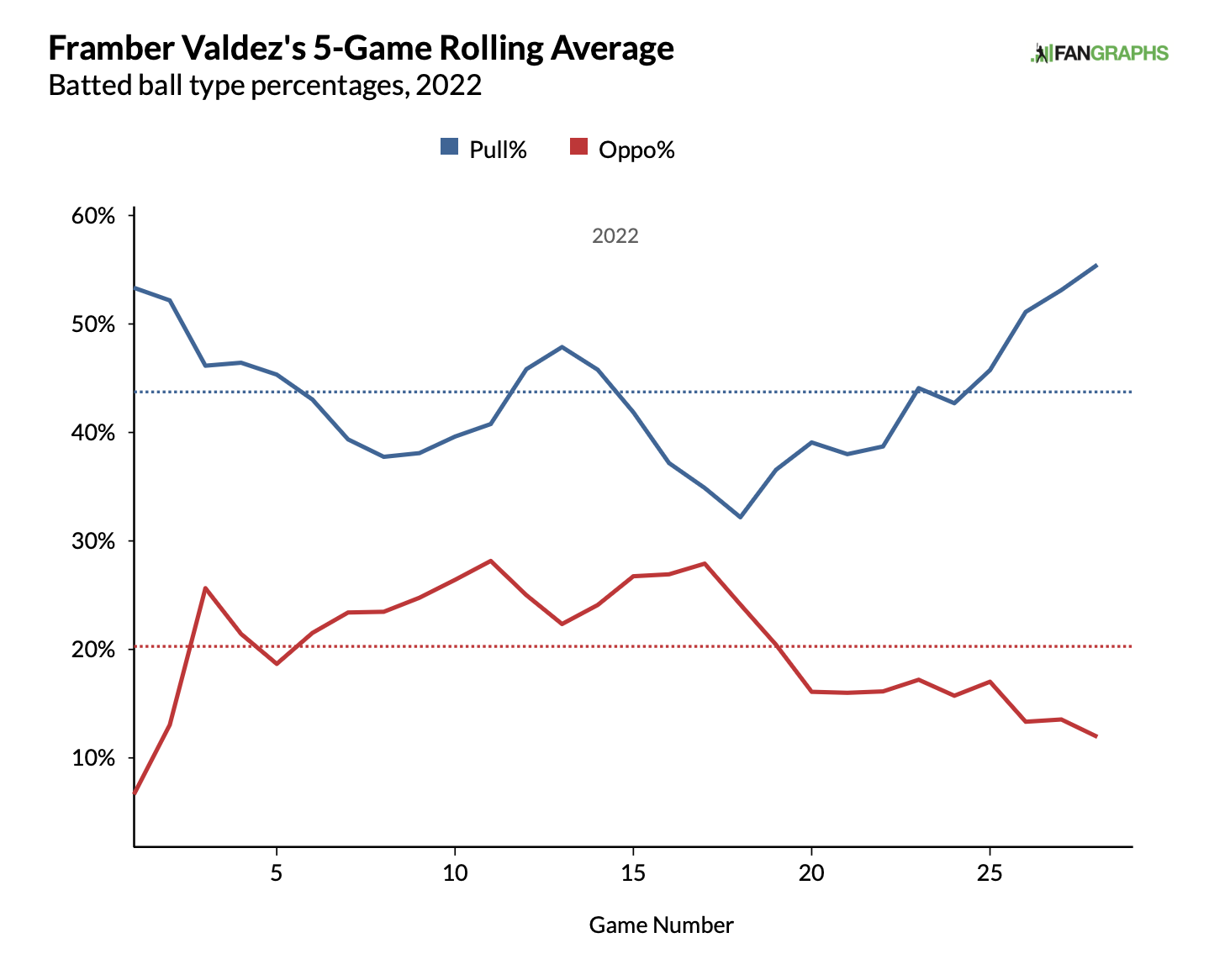
Most pitchers tend to get better outcomes on opposite field contact and worse outcomes on pulled contact. Valdez, however, is the other way around (how many synonyms for “opposite” can I find before this article is done?). Opposite field contact has long been a problem for him. Throughout his career, he has been one of the worst pitchers in baseball on balls hit the other way. But on pulled balls, the reverse is true. Since Valdez made his debut, no pitcher (minimum 300 balls in play) has allowed a lower batting average, slugging, or wOBA on pull contact:
| Year | wOBA on Oppo | wOBA on Pull |
|---|---|---|
| 2019 | .422 | .413 |
| 2020 | .428 | .303 |
| 2021 | .585 | .226 |
| 2022 | .440 | .241 |
Valdez has been able to survive in spite of his unusual weakness by limiting opposite field contact in favor of pull-side hitting. In 2021, only 19% of balls put in play against him went to the opposite field. More than half the time, those batted balls fell for a hit, but Valdez could shoulder that burden because he allowed opposite field contact so much less often than the average pitcher. This year, the southpaw has taken it up a notch. Since July 9, his opposite field contact rate has been steadily dropping. More and more of the balls put in play against him are being pulled or hit straight up the middle. Through the first three months of the season, Valdez allowed an opposite field percentage of 24.7%, right around league average. Since then, just 14.9% of balls put in play against him have gone the other way. That figure ranks first in the AL by a wide margin.
For most pitchers, this would constitute a disaster, but this is Framber Valdez we’re talking about. The man thrives on pulled contact. Since his opposite field percentage started dropping, he ranks second among AL pitchers in innings pitched and fourth in WAR. Every single one of his outings, as we know, has been a quality start. He is averaging over seven innings pitched per appearance.
In the first half of the year, he allowed 14 runs to score on balls hit to the opposite field. Since then, he has allowed two. It’s no wonder he has been able to pitch deeper into games.
Perhaps most impressive of all, Valdez has not allowed a single opposite field home run since July 3. In the first three months of the season, he allowed four. Of course, some of that can be chalked up to luck – Valdez has still allowed several hard hit fly balls to the opposite field, and eventually one of those is going to go over the fence – but by keeping the sample small, he has put himself in a position to benefit from such good fortune.
And speaking of good fortune, Valdez ranks third among all pitchers in Outs Above Average while he is on the mound. He has benefitted from terrific defense behind him, more so than almost any other pitcher in baseball. Some might chalk that up to good management or simply good luck, but in this case, Valdez also deserves some credit because he is pitching in such a way as to help ensure good defensive outcomes.
The type of contact Valdez allows differs depending on how his defense is set up. When the Astros are lined up in a traditional fashion (i.e. no shift), his opposite field percentage isn’t all that much lower than league average (it has stayed consistent throughout the season). But when Houston has a shift on, Valdez has learned to heavily limit opposite field contact:
| Time Period | Oppo% | Cent% | Pull% |
|---|---|---|---|
| April 7 – July 3 | 25.3% | 33.5% | 41.1% |
| July 9 – Present | 10.2% | 39.8% | 50.0% |
When the Astros are shifting, Valdez almost never allows a ball to go the other way. That means his defense can focus almost exclusively on the pull side of the field. And it’s working. Since July 9, balls hit up the middle or pulled into the shift against Valdez have a puny .186 wOBA – and those batted balls make up 90% of the contact he has allowed in that time. That’s remarkable. Valdez has a terrific group of fielders behind him, and he has learned to pitch in tandem with them. All in all, it’s a great recipe for success.
And now that we know the recipe, it’s time to think about the ingredients. What is Valdez doing differently to achieve these results?
Well, to make my job a whole lot easier, Valdez implemented a change to his arsenal right around the same time his opposite field contact rate began to drop. In July, his new slider/cutter became a much more significant part of his pitch mix, especially against left-handed batters:
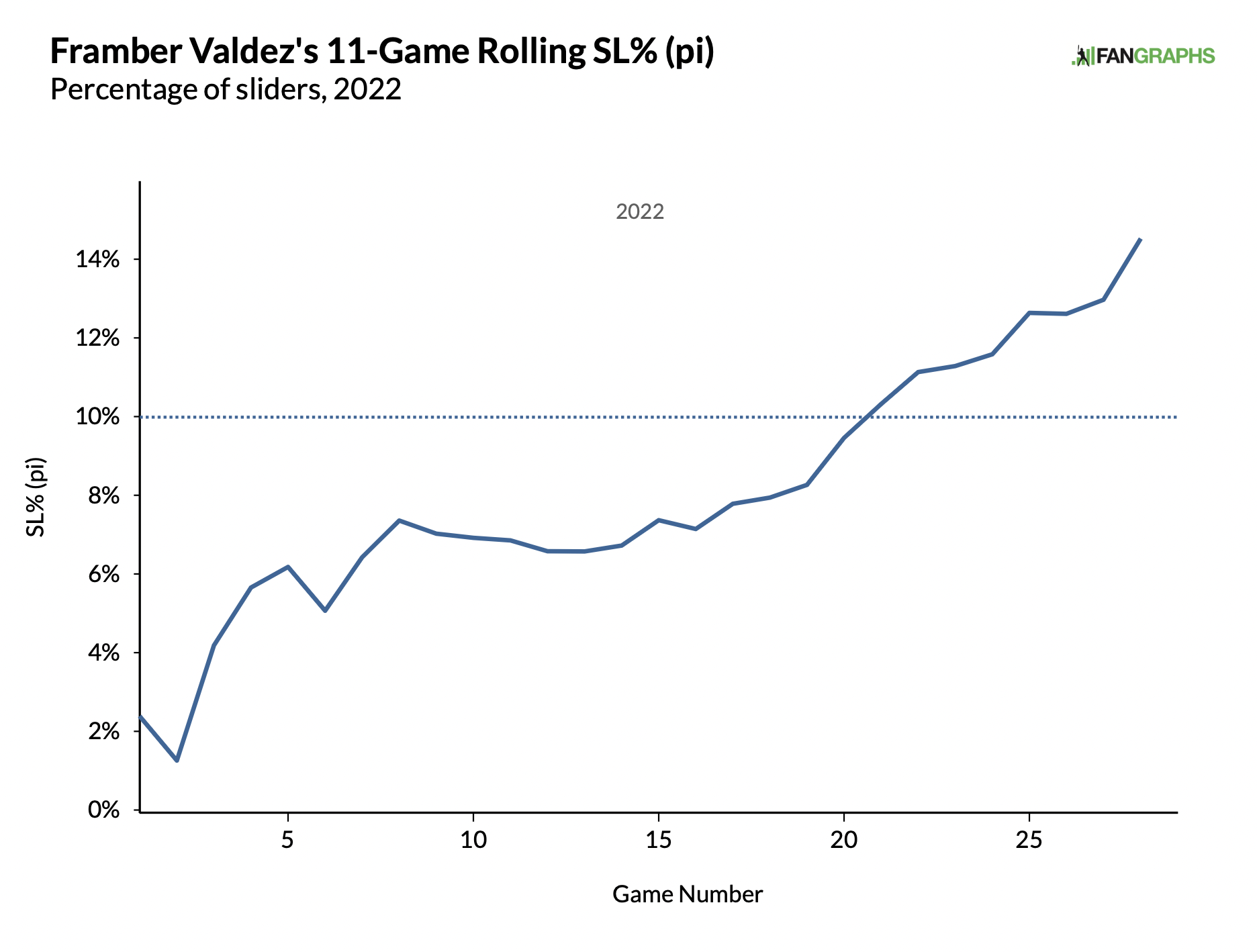
The pitch, which some sources classify as a slider and others have as a cutter, was a new one for Valdez this season. He introduced it early in the year, just trying it out at first and slowly getting more comfortable with it over the first three months of the season. More recently, it has become a major weapon. His slider/cutter rate since July 9 is double what it was over the first three months of the season. He has even started to throw it more regularly against right-handed batters.
And what do you know? As it turns out, opponents almost never hit Valdez’s cutter/slider to the opposite field. You could probably count on one hand the number of those pitches opposing batters have hit the other way. This pitch goes a long way in explaining how Valdez has been able to limit opposite field contact from left-handers:
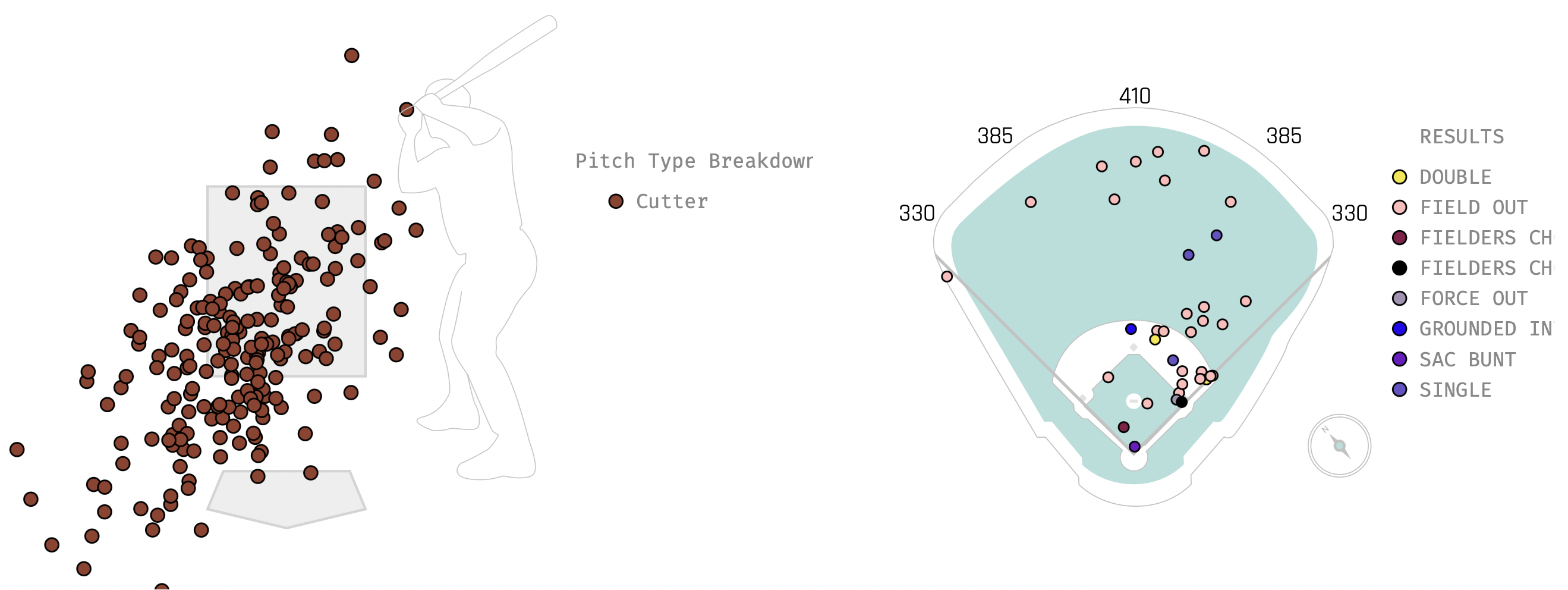
As for right-handed hitters, who Valdez is much more likely to face anyhow, the situation is a little more complicated. There isn’t one clear change in his arsenal, but he has been throwing a few more curveballs, changeups, and slider/cutters against righties over the second half of the season. All three of those pitches have been more likely to result in pulled contact. In addition, Valdez is throwing his sinker a little bit less, and his sinker tends to result in the more opposite field contact than his other pitches.
Beyond changing up his pitch mix, Valdez has also been changing up his pitch locations. Specifically, he has been throwing both his sinker and his changeup closer to the inside of the plate against righties. As common wisdom tells us, hitters are less likely to send inside pitches to the opposite field.

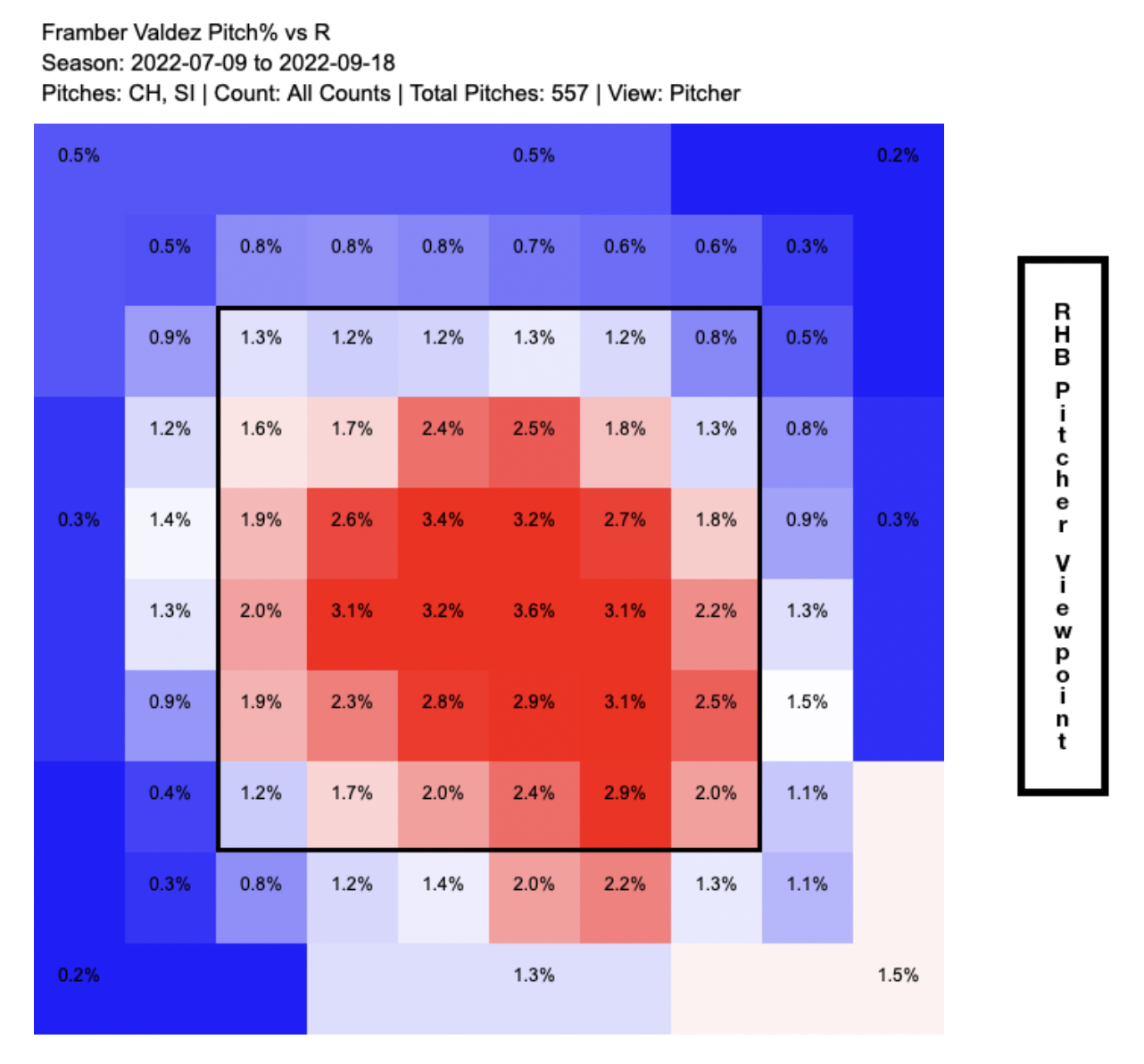
There might be more to Framber Valdez’s new approach against righties than a modest drop in fastball usage and a slight shift towards the inside edge of the plate, but if there is, you’d better believe Valdez and the Houston Astros are keeping that secret close to the vest. This new approach has been working out phenomenally well for them thus far. However he’s doing it, it’s clear Valdez is altering his game plan to induce less opposite field contact, and it’s clear that it’s working.
Leo is a writer for FanGraphs and MLB Trade Rumors as well as an editor for Just Baseball. His work has also been featured at Baseball Prospectus, Pitcher List, and SB Nation. You can follow him on Bluesky @leomorgenstern.com.

I’ve not noticed Valdez getting more batted balls to the pull side. The cutter versus lefties has been nice.
The OAA while he’s on the mound is surprising. Pena’s great. The other infielders are usually just okay (though Bregman almost singlehandedly kept the QS streak alive in the last start), and Framber Valdez starts is usually when the Astros deploy their worst defensive OFs (granted it seems like Alvarez has thrown 6 or 7 guys out at home during Valdez starts).
Interesting insight. I’d guess that the defense doesn’t seem so spectacular because they’re making so many hard plays look easy by shifting really well and with Valdez pitching right into the shift.
I don’t think OAA gives credit for positioning (i.e., if ball is hit right at a shifted fielder, the fielder gets 0 credit even if would have been a hard play for an unshifted fielder) other than fielders getting more chances to make plays. I’d guess the high OAA is mostly a function of Framber getting a lot of groundballs such that Pena has more chances to shine.
Yeah, I know what you mean. But I think there can still be some sort of relationship between good positioning and OAA.
If player is a positioned perfectly, they’re more likely to make plays, and as long as they’re making plays they can’t bring down the team OAA. If players aren’t positioned so well, they’ll be at higher risk of messing up. So in other words, good positioning limits the amount of damage bad defenders can cause.
For instance, someone like Yordan isn’t a good outfielder. But as long as he barely has to move, he can catch the ball pretty much as well as an average outfielder. Per Statcast, he’s at a -4 OAA this year when playing straight up, but when shifted left or right he’s at a perfectly neutral 0 OAA.
Similarly, Astros left fielders are at -4 OAA this year, but when Valdez is pitching that number is 0.
So by positioning their players well, the Astros could be limiting the damage their poor defenders can cause. When you then combine that with elite defense from Peña and the center fielders, the extra high OAA makes sense.
I’m just thinking out loud here, but I think this tracks.